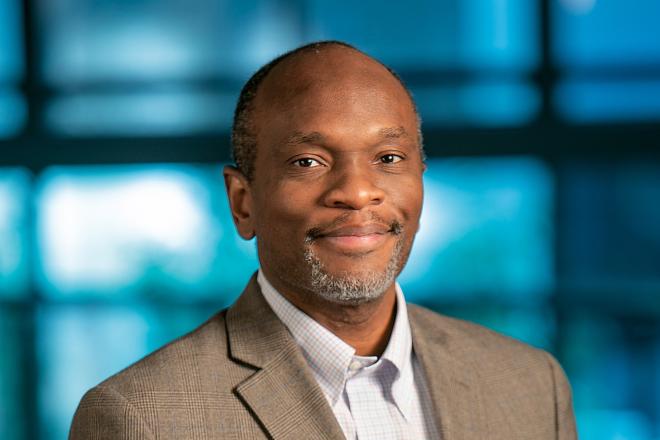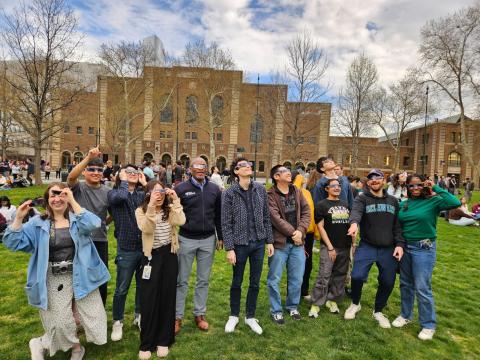Faculty Spotlight: Chinedum Osuji
In our faculty spotlight series, we feature a Q&A with Chinedum Osuji, a faculty fellow of the Environmental Innovations Initiative and professor and chair in the School of Engineering and Applied Science.

By Yamila Frej
Chinedum Osuji, a faculty fellow of the Environmental Innovations Initiative (EII), is the Eduardo D. Glandt Chair and a professor in the Chemical and Biomolecular Engineering department of the School of Engineering and Applied Science. In his role, he’s responsible for faculty affairs and the CBE undergraduate and graduate programs.
His research focuses on the dynamics of soft materials, including, in part, a concern with how the design and structure of materials such as membranes could affect water filtration, separation of metals, and more. In a Q&A with EII, Osuji describes his research and its connections to sustainability and the environment, explores how industry and researchers could work better together, and shares what excites him most about teaching the next generation of chemical engineers.

Can you share a bit about your research, how you became interested in the field, and what drew you to the Penn?
My lab in general works on the structure and dynamics of soft materials. So, we care about structure, meaning how atoms and molecules are arranged, and how that structure gives rise to properties. For example, the structure of a material can impact a property we care about, like ion permeation, the speed at which ions move through a material.
We also study the dynamics of soft materials. That mostly takes the form of experimental investigations of rheology of complex fluids. Rheology refers to how things flow. And complex fluids are systems that result from interactions among components in fluids. For example, if you take just water, we call that a simple fluid. But if you start adding things like colloidal particles, or polymers, or surfactants, then it becomes more complex in its behavior. And so things that we encounter everyday like toothpaste, or mayonnaise, or the ink in your laser printer, or paint, those would be examples of complex fluids. My lab does research on understanding how the components in a complex fluid change the flow behavior of that fluid.
Going back to the study of structure, properties, and soft materials, a big topic for us there is looking at the self-assembly of polymers and liquid crystals. We study structures that are formed spontaneously by these materials, in response to changes in temperature or concentration, and then how these spontaneously formed structures impact the material’s properties.
Ion transport is one of these properties of interest. We care about making polymer membranes for controlling ion transport. We also care about making polymer membranes for water purification by nanofiltration. How well can the polymer reject contaminants from water? That depends on certain aspects of the of the structure of the material. The ability of the membrane to transport one ion over another is also very important for separation of metals; for example in the recovery of valuable metals from consumer electronic waste, or tailings from mining operations.
I got interested in all of this many years ago, when I was an undergraduate at Cornell. I did research there on polymers and that interest took me through to graduate school, a postdoc, starting my career at Yale University, and then here to Penn in 2018. The reason I came is that we have a lot of strength in soft materials research here. There are lots of people here in not only engineering, but also physics and chemistry, and even in the medical school. We certainly have critical mass.
What are the key challenges and opportunities for integrating sustainability into chemical engineering industries?
Wow, there are a lot! One is simply the absence of technology or science solutions. In some cases, we don’t have the technology or the materials or the processes that can provide more sustainable alternatives to the current state-of-the-art, or currently used processes, materials, and methods. In other cases, adoption and scaling up of existing solutions is the main challenge. So it’s multifaceted. In some of the areas that I do research in, it’s simply that we lack the technology solutions, we lack the materials, or we lack the ability to produce those materials at scale, to get them into the chemical industry.
What changes do you hope to see in the field of sustainability in the future?
That’s a really good question. Sustainability is such a broad field. It’s a term that covers a great many things, but I guess the change that I would hope for the most is adoption. You know, I think we have a decent sense, in many cases, of what it takes to operate in a more sustainable manner. But we’re not yet there in terms of adoption, or in terms of doing it at scale and in practice. So I think that's a challenge. And it’s something that I hope we will do better at in the future.
What do you see as Penn’s impact on supporting those aims?
Well, that, again, is a multifaceted thing. Penn obviously, is a very visible institution. And so what it does is important to others. One way of having impact then is by providing a good example to others. That could be in the types of buildings that we build, or the types of HVAC systems that we use in our existing buildings. It could be in how committed we are to recycling for example, or to, you know, using non disposable coffee mugs, something as simple as that, throughout our buildings and our daily lives.
Penn also can lead of course through science and research. There's a lot of research that takes place at Penn, across many different departments, some dealing with developing technology and materials, others dealing with studying human behavior and how you can modify human behavior. There’s a huge range and Penn can and is leading through its scholarship in many areas.
How is your work being impacted by the conversations and policies around renewable energy and green technology?
Quite a bit. In my lab, we do a few different things. One of the things that we care a lot about are membranes, or membrane technology. My lab works to develop membranes that can decrease the energy intensity of certain chemical processes and in particular, chemical separations. A sizeable fraction of energy consumption globally is devoted to chemical separations – roughly 10-15%. That’s an enormous amount. If we can reduce the energy use associated with hydrocarbon separations (e.g. separating mixtures of organic solvents into their constituents; or commodity scale chemical feedstocks such as isomers of xylene that must be purified to make polyethylene terephthalate – the plastic used in plastic bottles) we could have a big impact.

Critical mineral recovery is another area, as I alluded to earlier. And so a focus on sustainability in these and related areas has energized work in my lab. It’s sharpened our focus and made us even more committed to developing technology solutions in that area.
How can collaboration between academia and industry further the development of sustainable practices?
A lot, I think. In some cases, industry is actually out ahead of academia. And in other cases, industry is lagging. At the end of the day, solutions need to be implemented at scale, in industrial settings, to really have an impact on society. I think that industry and academia could do a lot better in working together. Sometimes, it's simply a question of knowing what questions to ask or what the actual problem is. Folks from industry will tell you that sometimes intellectual property is the question itself. Overall, I think the more industry works closely with academia and lets academic researchers know more about the specific problems that they're trying to solve, the faster I think we’ll move.
How can chemical engineers effectively communicate the importance of sustainability to non-technical stakeholders?
There are a variety of ways. I get the sense that the importance of this has permeated all corners of society. People can perceive changes in climate, they can perceive the impact of more intense storms, more intense heat during the summer, they can perceive the impact of pollution. So I think awareness is at a much higher level than it ever has been.

Chemical engineers, or those with a technical background who are seeking to talk about this with those who have less of a technical background would do well to draw from examples that are well known, and to use that simple language. So we all went through, you know, the Y2K crisis, right? We went through the challenge of having a hole in the ozone layer. We responded, as a global society, to the depletion of the ozone layer that was caused by certain harmful propellants that we use in aerosols, for example, and addressed that challenge collectively. And so there are examples of society—countries, nations—coming together to take concerted action in the face of critical threats. And I think that we should think about sustainability and climate change in a similar vein. I think by alluding to these successes of the past, and keeping the language simple, we can get to a better place and raise awareness even higher of the need to take on these challenges.
Tell me about some of the courses you teach and what excites you about them.
This fall I will be teaching CBE 1600, which is introduction to chemical engineering. It’s a course that is typically taken by first-year students who are interested in majoring in chemical engineering. That's a really exciting course to teach, because these are students who, six months prior, were in high school. So, it’s their first introduction, for many of them, to formal engineering coursework, and certainly to chemical engineering. It’s always interesting to see how their perspective changes: what they think chemical engineering is at the start, and then see how that evolves throughout the semester, as they're exposed to more and more facets of the discipline.
In the spring I taught a grad elective that I've been teaching since I think 2019. It's CBE 5700, which is covers theory and practice of experimental methods in polymer science and soft matter. It’s primarily lecture based, but we also go into the lab and do some experiments. I cover the theory behind things like X-ray scattering, rheology, and other experimental techniques that are used to study soft materials and polymers. And then we go into the lab, and we do a few experiments, and we analyze the data using the theory that we cover in the lectures. The course has been updated in recent years. Now there’s a section on autonomous experimentation, which is really exciting. That’s an area in which we use computers to drive experiments, not just to automate the experiment, but to actually automate data analysis and preparation of additional experiments. So, there’s a workflow that’s completely computer controlled, which is a pretty cool, new area for us.
To learn more about Dr. Osuji, please visit his lab research site.